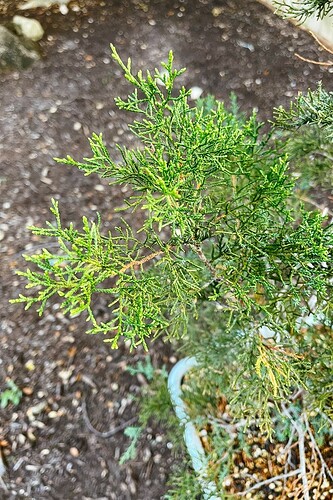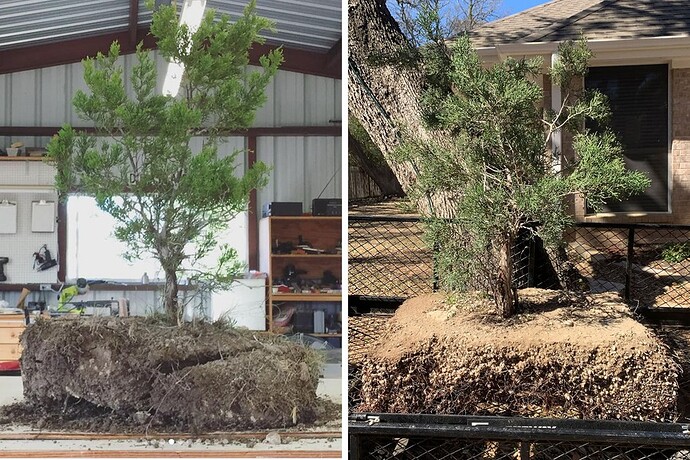Yeah, I kinda figured that out after the fact. I didn’t spray them off or anything, but I removed the majority of the soil, half way intentionally, half way unintentionally. I suppose you’re right, just hope for the best. I really hope they make it, because my boss is showing an interest in bonsai, and I ripped half of them out of his yard!!!
A question I am struggling with now is when do I take out from under my patio and get out some sun. I know don’t let it get exposed to freezing temps and o don’t want to do the bonsai shuffle with it due to it just being potted recently but I want to make sure I don’t keep it out the Sun too long and it struggles from that. I have been to conservative in the past and trees have suffered because of it, so I want to do the best thing even if it’s not the conservative thing.
Thanks.
Every plant and environment is different, but I like to wait for the soil to dry out at least twice or two weeks. Whichever is sooner. I repotted my cupressus arizonica a little over two weeks ago. It’s only dried out once and is still pretty moist, but I want to get it out in what little sun we have. Not much threat of freezing here, but wind is no joke.
When the day time temps are at 10C is the ideal time to begin hardening off trees that have been sheltered during the winter. Place them outside in a sunny / sheltered spot for the warm days but bring them back into shelter at night. Do this for 2 -3 weeks until the night time temps remain at 7 - 10C. Then you can leave them outside for the duration. If you are likely to suffer severe frosts then simply place it back in shelter until the frost has passed.
@jjenk321 how did these yamadori juniper fare? Especially the one large root chop?
.
I have the misting equipment, but have not set it up in years. I guess it would help with the 100F+ we have here.
.
Love the boxes…
@KurtP my collected tree has not made it. Although I think you mean to ask @bigorangedrink about his as he has the nice boxes. Mine slowly degraded over time and I feel like it never really made its way toward recovery. With that said, I don’t know that there is anything I would say I would do differently. Bummed but definitely will be trying again next year.
Sorry to hear @jjenk321 I’m very curious as well. I I did not mist mine as I did not have a automatic watering system in place, but I have since built one so it will allow for more targeted irrigation after the next collection season. I did water the foliage almost daily for the first few weeks… I had 50% loss. The trees collected were not “great” I left those in the ground until I have a better survival rate. These “experimental” Ashe created loads of questions tho. Some I thought were doomed did great, others that I thought were destined to survive didn’t despite larger root mass/ball. Very curious to hear about post collection experiences from others. @bigorangedrink @Les-in-New-Mexico @ttman
Sad,
The tree that I posted early in this stream did not make it through the collection process. I’m attributing this to an inadequate root ball, not misting as soon as it was placed in the box and the three days at 6 degrees F that we had in March. I had it wrapped up, on a heat mat with other trees around but the hard freeze pushed it over the edge.
I’m also considering a collecting trial this fall, maybe in Oct. This will be a big commitment to keep anything collected from freezing but I’m wondering if a longer period of vascular growth (roots) may improve survival. I’m still anticipating shade cloth and misting aggressively initially.
I am also planning on a collection trial during deer season. I’m betting on no more generational winter storms, roots crossed. 
I don’t have more to add to my original post regarding the collection and immediate aftercare of Ashe Juniper, other than to say the six I referenced are still alive.
I can, however, provide an update on that first tree I dug back in January of 2019. Again, this Instagram post documents its dig and boxing.
It remained in this box, untouched for two years. In March of this year (2021), I entirely bare rooted and repotted this tree in bonsai soil. To be clear, this was in direct contradiction to advice I received from Ryan, and others. ![]()
After learning the first repot is critical to the bonsai success of an Ashe Juniper, I consulted several who have gone before me—both local experts and Ryan himself, in Forum Q+A 88 (00:17:03 - Ashe juniper / Repotting). The consensus was to both reduce the rootball and introduce bonsai soil over the course of multiple repottings—whether that be the half-and-half approach or, as Ryan suggested, from all sides and ultimately the shin.
But then I spoke with a gentleman in the Dallas area who offered up a different approach. He swears by bare-rooting the entire tree with a gentle stream of water. He was adamant about not using a chopstick, attributing his success to doing less damage to fine roots.
I took his advice.
It took four hours to remove all the field soil, but it was a lot of soil. I used a 2:1:1 APL mix and a much smaller container. Here is the tree today.
These aren’t great photos but they do document its health, six-months post-op.
I repotted three of my Ashe this way, all in March of 2021. The other two were quite a bit smaller but all are alive and in good health.
Here’s an interesting side-by-side of the rootball at the time of collection and two years later. I found so many fine roots in the pumice, which surely contributed to the successful repot. But again, I hesitate to call this success ![]()
That is great news. Thanks for the update. Congratulations on the survival rate! It would seem to me that the box/pumice/misting method you employed post collection was paramount to your recovery. In terms of the 2-1-1…was the 2 akadama 1 lava 1 pumice?
That’s the mix, @moon , yessir. Thanks!








